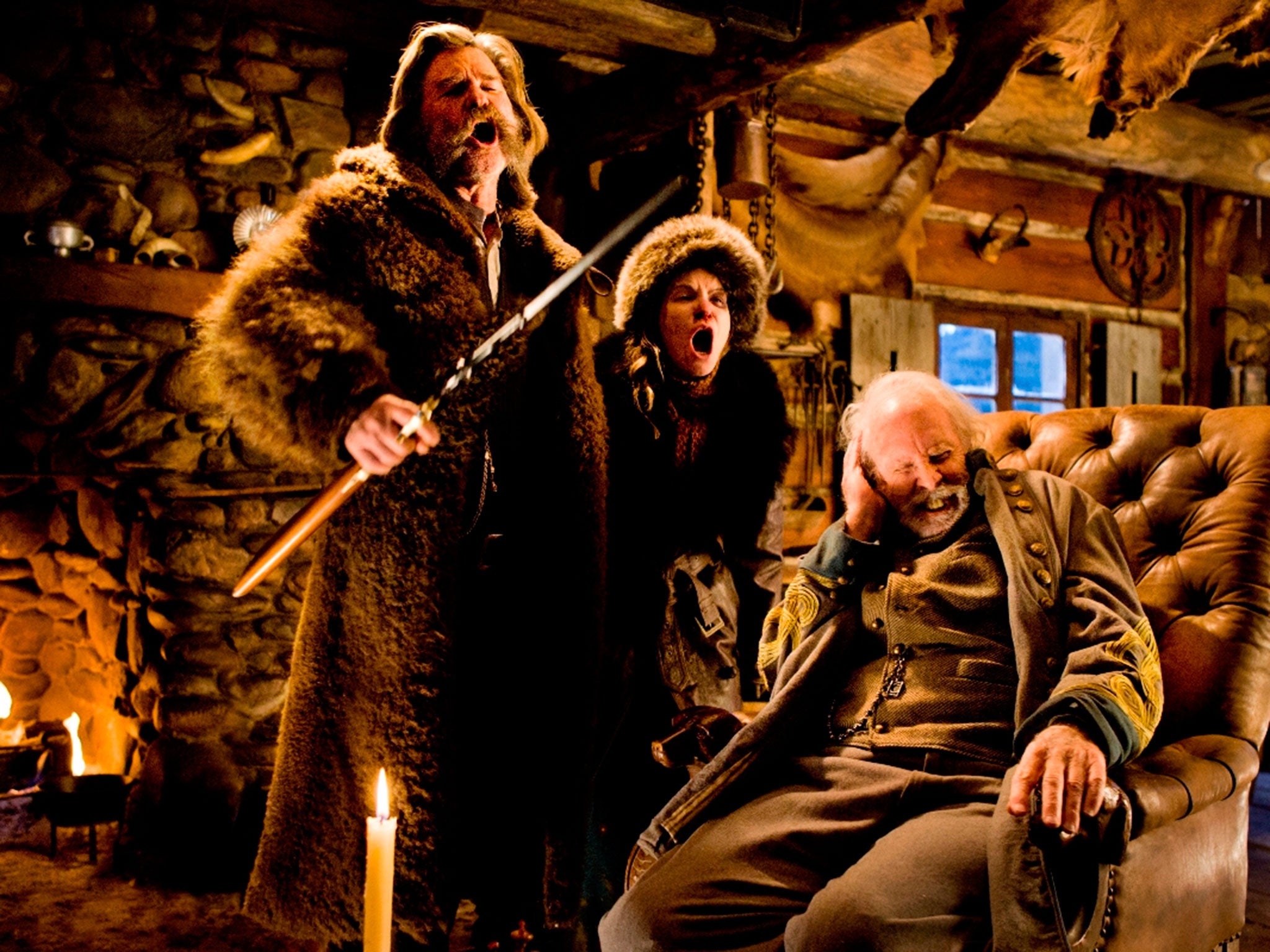The Hateful Eight: Celluloid lovers screening vintage 70mm print of Quentin Tarantino's epic Western
Delivered as a single reel of film weighing 90kg, the 70mm edition of the film requires several people to lift it into place

Gordon Elliott and Adam Witmer have never met, but the 55-year-old projectionist from London and the 22-year-old film student from North Carolina share a deep love of celluloid.
The two men are part of an international effort to screen the 70mm print of Quentin Tarantino’s eighth film, an epic Western called The Hateful Eight. Mr Witmer has been running the picture four times a day at a cinema in Los Angeles; Mr Elliott is gearing up for screenings at the Odeon in Leicester Square which begin on Friday.
Tarantino’s decision to shoot The Hateful Eight using Ultra Panavision 70 – a vintage format with frames that are considerably larger in size and wider in aspect ratio than the standard 35mm frame – has been hailed by those with fond memories of glorious 70mm prints of films such as Lawrence of Arabia and West Side Story.

But the resulting print – the film runs for three hours and features both an overture and an intermission – presents a unique set of challenges. Delivered as single massive reel of film weighing about 90kg, the 70mm edition of The Hateful Eight requires several people to lift it into place. And unlike digital screenings, which don’t require the intervention of a projectionist, the 70mm film projector – which is fitted with a £15,000 anamorphic lens – must be watched carefully as the film spools through the gate.
“I love running film,” said Mr Elliott, who screened his first 70mm film, the original Star Wars, in 1978. He was made redundant in 2013, but was rehired after Odeon realised the heavy demands of running a 70mm print of Christopher Nolan’s 2014 space epic Interstellar, one of a handful of films that testify to the format’s popularity with a new generation of directors. Much like vinyl records, film has its fans who say digital can’t compete. “When I run film, I always find there’s more depth to it. Digital is like watching TV to me,” Mr Elliott said.
Mr Witmer feels the same way, but also knows that the beauty of 70mm film comes at a price. On Christmas Day, as he was preparing for a screening of The Hateful Eight, his manager dropped a bombshell: Tarantino had turned up at the cinema unannounced and wanted to watch the show. “No pressure,” joked the manager, as the director of Pulp Fiction and Reservoir Dogs took a seat in the fourth row.
Things went fine … at first. But Mr Witmer’s blood ran cold when he noticed that the film was being pulled through the projector faster than the platter – the large disc holding the print – could deliver it. The screening was almost certainly heading for disaster. “It [the celluloid] could have wound itself into a massive knot,” Mr Witmer said. “It could have torn or it could have burned up – it would certainly have stopped the show.”
Realising that a tension arm was stopping the platter from spinning fast enough, he grabbed the arm with his fingers and pushed it to the left, freeing the film. For the next 90 minutes, he and another projectionist took turns to stand and hold the arm aside. The audience was oblivious to the drama in the booth, but Mr Witmer was left with a sore back and a story to tell his grandchildren.
Not every projectionist has been as fortunate. Early US screenings of The Hateful Eight were “plagued with projection problems”, according to the trade magazine Variety. It cited comments on social media that described poor focus, loss of sound and “soundtrack synching issues”.

Watch Apple TV+ free for 7 day
New subscribers only. £8.99/mo. after free trial. Plan auto-renews until cancelled.
ADVERTISEMENT. If you sign up to this service we will earn commission. This revenue helps to fund journalism across The Independent.

Watch Apple TV+ free for 7 day
New subscribers only. £8.99/mo. after free trial. Plan auto-renews until cancelled.
ADVERTISEMENT. If you sign up to this service we will earn commission. This revenue helps to fund journalism across The Independent.
Mr Elliott acknowledges that things can go wrong, but three test screenings at the Odeon have gone off without a hitch. Nothing is being left to chance, however. Two projectionists will be in the booth at all times, one standing next to the projector, the other ready to jump in.
Is it worth all the trouble? Absolutely, said Mr Witmer, who described the difference between the 70mm print and the digital edition as “amazing”. “Emulsion creates an actual physical barrier between the [projector] lamp and the screen,” he said. “That gives you much more dynamic range than digital – the blacks are truer and the whites are much brighter. That contrast also makes everything look crisper.”
The Hateful Eight will be screened in Panavision 70 at the Odeon Leicester Square from 8 January
Join our commenting forum
Join thought-provoking conversations, follow other Independent readers and see their replies
Comments